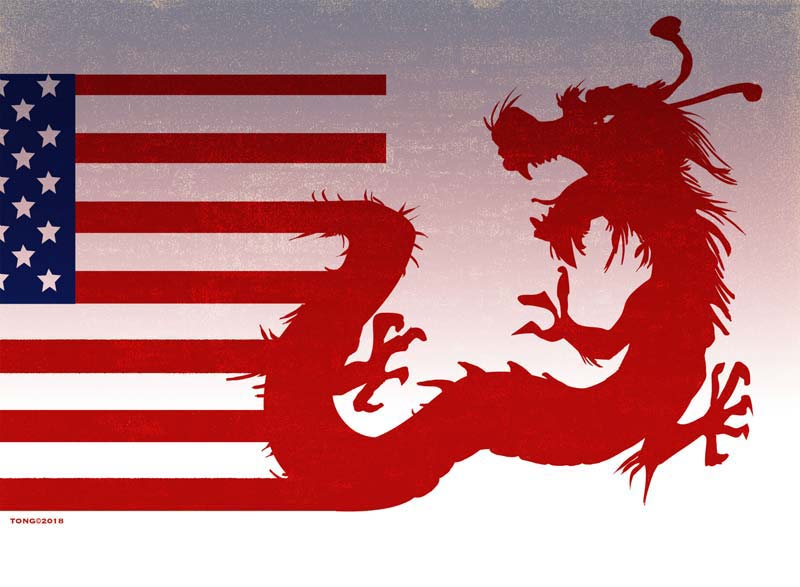Americans have a habit of thinking about China in this light.
For the longest time, the intelligentsia in our country assumed Beijing's Communist system would collapse on its own, just as the Soviet Union's did.
Of course, the West had a policy of containment toward the USSR — in contrast to a policy of encouraging China's integration into global institutions like the World Trade Organization in the 1990s and 2000s.
But if relying on globalization to turn China into a democracy was a failure, today optimists see another way to get Beijing to defeat itself.
The strategy depends on demographics.
Chinese birth rates, like those in most of the industrialized world, have plummeted.
India surpasses China as the world's most populous country this year, according to United Nations estimates.
Each has more than 1.4 billion people, but India is still growing, while China's population, as of last year, is shrinking.
China's own National Bureau of Statistics says that the fertility rate — births per woman — is only 1.0 to 1.1, far below the replacement level of 2.1.
And China's population is aging: The country's National Health Commission projects that by 2035, it will have more than 400 million people over the age of 60.
The ratio of retirees to workers will rise with no end in sight.
Some of China's neighbors are in worse shape, to be sure.
Taiwan had a total fertility of just 0.87 children per woman in 2022, one of the lowest levels in world history.
The U.S., on the other hand, has a total fertility rate of 1.66, according to Congressional Budget Office estimates, and that will increase to 1.75 by 2030, as more older women give birth.
But what really gives America a demographic edge, say the optimists, is immigration.
Despite fertility levels below replacement, the U.S. population grows every year thanks to immigration.
Can an aging, shrinking and, of course, unfree China compete with a younger, growing and free America?
Asking that question, many liberal pundits and policy wonks feel as cocksure as they felt in 1999.
But they were wrong then.
Globalization only made China stronger, and it fractured America's social compact, leading to the intense polarization of our politics today.
The highly educated winners of globalization are on one side; abandoned Americans turned to populism, nationalism and Donald Trump.
Overconfidence in immigration-driven demographics will lead to similar upheavals.
The proportion of foreign-born persons in the United States today, some 13.7%, is about as high as it was at the peak of the last great wave of immigration in the early 20th century.
Back then, pressure on immigrants to assimilate was enormous — and even so, immigration was political dynamite, with voters ultimately so concerned that they elected Republicans who restricted immigration for 40 years, a pause in which assimilation could take root.
Today, however, multiculturalism, rather than assimilation, is the official ideology of at least one of our political parties and almost all our elite institutions.
Public schools, which enforced assimilation a century ago, now teach students to celebrate every kind of identity except the traditional American one.
Another difference is that 21st-century immigration is global: China and India are in fact two of the leading sources of legal and illegal immigration to the U.S. today.
There were intense conflicts between Protestants and Catholics, Christians and Jews, in the earlier era, but these groups also had a common religious heritage.
That's less true of immigration today, and it's one of the factors driving the change in America's spiritual demographics, from a country with a huge Christian supermajority and broadly Christian culture to one with a dwindling 63% Christian majority and no common religious foundation.
The significance of the greater cultural and ethnic diversity of immigration today, at a time when our institutions reject assimilation to the historic American character, is that it undermines every sense of what it means to be a single people.
In an age when public trust in government is already strained to the breaking point, and each party hardly accepts the democratic legitimacy of the other, calling the cohesion of the people into question is not only reckless; it's potentially suicidal.
That's what Beijing is counting on.
In 2050, China will be grayer.
But old men don't start revolutions, and their dependence on the state is all the greater.
America's wealthy whites will be old, too, and younger, poorer Americans, taught to question the nation's past, may well wonder why they should sweat to pay for the former majority's retirement — or for its pledges to Europe and East Asia.
Population matters, but continuity of character matters more. Without that, a nation ceases to be.
(COMMENT, BELOW)
Previously:
• 07/18/23: The Frontrunner Who Looks Like a Loser Is Biden
• 07/11/23: Britain's Bad Example for American Conservatives
• 07/05/23: Could We Still Win a Revolutionary War?
• 06/27/23: Civilizations Clash -- in Ukraine and at Home
• 06/20/23: China Comes for the Caribbean
• 06/13/23: Fertility, Family and Bio-Socialism
• 06/06/23: From American Dream to Orwell's Nightmare
• 05/23/23: Ukraine war is an existential struggle --- for the West
• 05/23/23: Learn the Right Midterm Lessons -- or Lose in 2024
• 05/16/23: Feinstein Today Is Biden Tomorrow
• 05/09/23: Trump, DeSantis and Political Courtship
• 05/02/23: RFK Jr.'s Threat to Biden
• 04/25/23: Biden's Lost Generation
• 04/25/23: Who's In Charge of Clarence Thomas?
• 04/11/23: Beyond AI, Our Cyborg Future
• 04/04/23: 2024: 3 Leaders, 1 Way to Win
• 03/28/23: Climate Science Makes a Bad Religion
• 03/21/23: All the Conspiracy That's Fit to Print



 Contact The Editor
Contact The Editor
 Articles By This Author
Articles By This Author